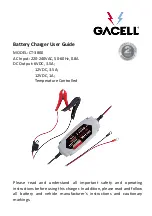
D
-
Sporty driving or driving on a
downhill gradient
The brake pedal does not need to
be used as often because the
extent of the deceleration is
greater than in D.
Energy use when decelerating is
considerably higher than when
the vehicle is braked with the
brake pedal.
D
AUTO
(radar-
based)
The intensity of recuperation is
automatically adjusted to the cur-
rent traffic situation.
Default setting
In levels D and D
-
, deceleration can be control-
led in an infinitely variable manner using the
accelerator pedal.
The braking performance of the electric motor
using recuperative braking is, in some operating
modes, either reduced or not effective:
R
when the charge status of the high-voltage
battery increases
R
if the high-voltage battery is not yet at a nor-
mal operating temperature
R
when driving close to the maximum design
speed
R
when the vehicle is almost stationary
R
in transmission position N
R
during and after ESP stability control
If you do not make an additional effort to apply
the brake yourself, the braking effect may not be
sufficient. If necessary, counteract the reduced
regenerative braking effect by applying the
brake yourself.
Radar-based recuperation
The vehicle uses the sensors of COLLISION PRE-
VENTION ASSIST PLUS during radar-based
recuperation (D
AUTO
). The sensors detect the
distance to the vehicle ahead and its speed. The
intensity of recuperation is then automatically
adjusted to the current traffic situation.
The range can then be increased by storing
energy efficiently. Adjustment is infinitely vari-
able from overrun mode (no recuperation) to
maximum recuperation.
Maintain sufficient distance to the vehicle in
front. Mercedes-Benz recommends that you
activate COLLISION PREVENTION ASSIST PLUS
as a visual and acoustic aid.
Examples of radar-based recuperation:
R
Approaching a slower vehicle, a decelerating
vehicle or when following a vehicle downhill.
Your vehicle decelerates slightly and increa-
ses recuperation.
R
Driving when no vehicle is detected in front or
when a vehicle is detected in the far distance
or an accelerating vehicle is detected. Your
vehicle switches to overrun mode at higher
speeds.
R
Driving on a steep downhill slope. Accelera-
tion downhill is reduced and recuperation is
increased. This is comparable with shifting
down when driving downhill.
X
To activate radar-based recuperation: pull
steering wheel gearshift paddle
:
or
;
towards you and hold for about one second.
X
To deactivate radar-based recuperation:
briefly pull steering wheel gearshift paddle
:
or
;
towards you.
If you change between radar-based and manual
recuperation, the following levels are activated
depending on the selection via the steering
wheel gearshift paddles:
:
Steering wheel
gearshift paddle -
selects D
-
(maximum
recuperation)
;
Steering wheel
gearshift
selects D
+
(overrun)
In particular, the function of the radar sensors
can be impaired in the case of:
R
dirt on the sensors or obscured sensors
R
snow or heavy rain
R
interference by other radar sources
R
strong radar reflections, for example, in multi-
storey car parks
R
a narrow vehicle travelling in front, e.g. a
motorcycle
R
a vehicle travelling in front on a different line
Following damage to the front end of the vehicle,
have the radar sensor settings and operation
checked at a qualified specialist workshop
immediately. This also applies to collisions at
slow speeds where there is no visible damage to
the front of the vehicle.
If the radar sensors are not available, the system
switches automatically to level D with moderate
Transmission
133
Dri
vi
ng
and
parkin
g
Z
Summary of Contents for B 250 e 2015
Page 2: ......
Page 3: ......
Page 289: ...286 ...
Page 290: ...287 ...
Page 291: ...288 ...
Page 292: ......
Page 293: ......
















































